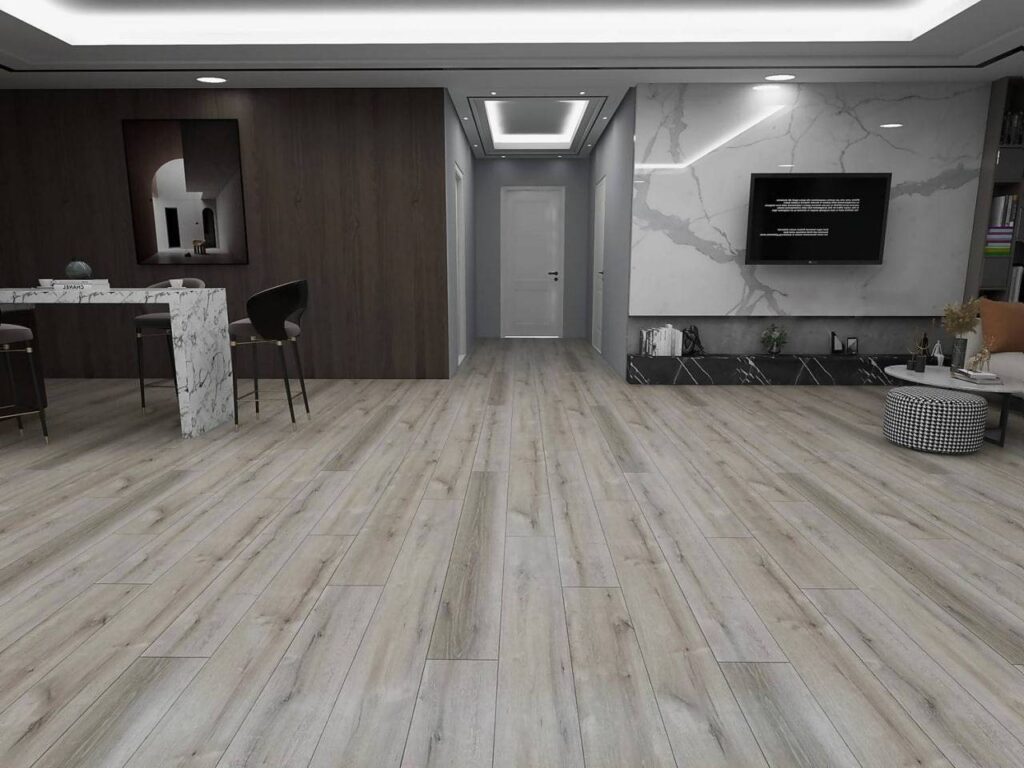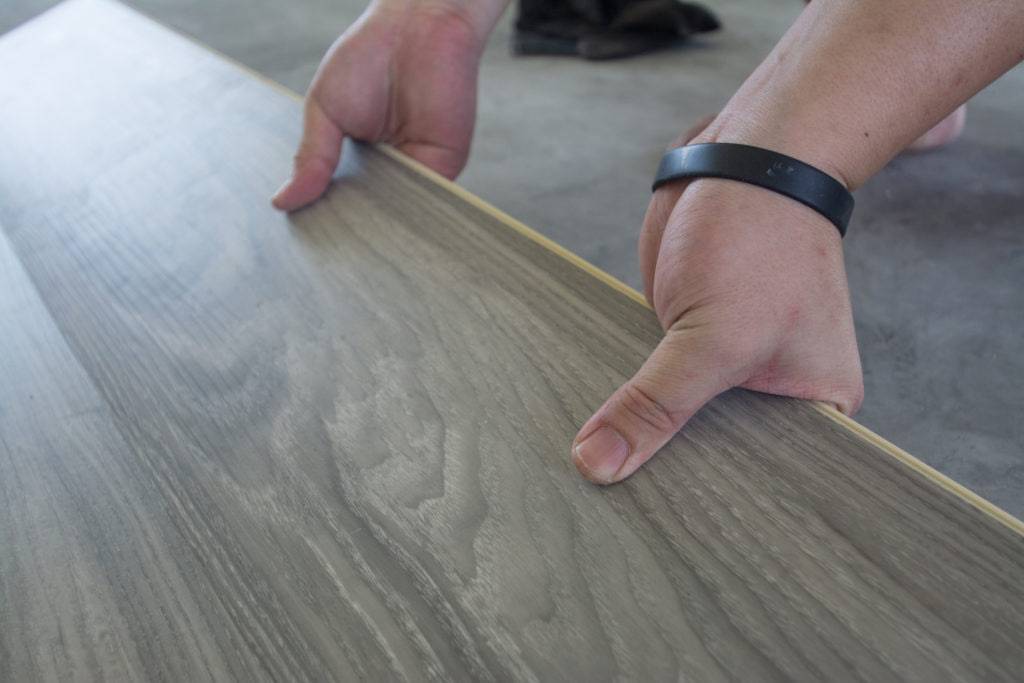My recent kitchen renovation turned into a nightmare – all because I wasn’t aware of the wonders of rigid core flooring. I meticulously installed beautiful oak hardwood, only to have it ruined by a leaky icemaker line. The water damage left me with no choice but to rip it all out and start again.
If only I had known about rigid core! This innovative flooring option is not only stunning and durable, but also incredibly water-resistant. It would have saved me countless hours of installation hassle and the heartache of replacing a brand new floor.
While it’s true that rigid core is synthetic, it comes in a vast array of designs, including realistic wood finishes. I likely could have found a style that perfectly matched the classic oak I initially desired.
Back then, as a professional hardwood installer, I was naturally biased towards real wood. But times have changed, and today, rigid core flooring is my clear favorite for kitchens. Its luxurious look and unbeatable water resistance make it a truly exceptional choice, living up to its name of “luxury vinyl flooring.”
The only hurdle might be the initial perception of its plastic-like feel. However, manufacturers are constantly improving the finishes, making them more realistic than ever before. So, ditch the outdated mindset and embrace the future of flooring – rigid core is here to stay!
What Is Rigid Core Flooring?
Rigid core flooring, a game-changer in the world of vinyl planks, boasts a unique layered construction that contributes to its exceptional strength, durability, and style.
Imagine a cake, but instead of sugary goodness, it’s a flooring masterpiece! Here’s the breakdown:
- Top Layer: Like the cake’s frosting, this scratch-resistant coating protects the floor from everyday wear and tear.
- Water-Resistant Topcoat: Think of it as a layer of icing that seals the deal, safeguarding the design layer beneath from moisture damage.
- Design Layer: This is where the magic happens! This layer replicates the beauty of natural materials like stone, ceramic tile, or wood, offering endless design possibilities.
- Rigid Core: The heart of the matter, this layer is typically made of crushed limestone or wood fibers combined with plastic resin. It’s what gives the flooring its remarkable stability and dimensional strength.
- Underlayment (optional): Some products come with an additional layer of water-resistant cork acting like a supportive base, providing both cushioning and insulation for enhanced comfort and sound reduction.
So, the next time you encounter the term “rigid core flooring,” remember, it’s not just a fancy name – it’s a testament to the innovative and multi-layered construction that makes it a top choice for modern homes.
Pros and Cons of Rigid Core Flooring
Rigid core flooring, the star of my recent kitchen renovation story, offers a unique blend of advantages and considerations. Let’s delve into both sides of the coin:
Pros:
- Waterproofing Champion: Unlike my unfortunate experience with hardwood, rigid core is 100% waterproof, making it ideal for moisture-prone areas like kitchens, bathrooms, and basements, where traditional flooring options might succumb to warping or separation.
- Design Chameleon: Embrace your inner designer with the vast array of patterns and colors available. From classic wood imitations to modern stone designs, rigid core caters to diverse aesthetic preferences.
- Comfort and Quiet: Products with a cork underlayment provide excellent sound and thermal insulation, creating a more comfortable and quieter living space. Imagine a muffled pitter-patter of footsteps and a toasty warm floor in the winter!
- Durability with a Warranty: Backed by warranties of up to 25 years, rigid core offers peace of mind, knowing it’s built to last.
- DIY-Friendly Installation: Save on installation costs by tackling the project yourself. Its user-friendly click-lock system makes it a breeze to assemble, even for novices.
- Versatility Reigns Supreme: Rigid core flooring thrives in various high-traffic areas, including laundry rooms, entryways, and even basements. Some brands even venture outdoors, expanding its application possibilities.
Cons:
- Comfort Quandary: While some products boast comfort through cork underlayment, others can feel as firm as hardwood, especially without that additional layer. Consider prioritizing brands that offer enhanced comfort if this is a concern.
- Longevity Limitations: While its lifespan is respectable, with warranties reaching 25 years, it may not match the longevity of traditional materials like hardwood or ceramic tile.
- Vulnerability to Scratches: Although the surface is scratch-resistant, it’s not invincible. Heavy foot traffic, playful pets, and spills can leave their mark over time, requiring extra care to maintain its pristine look.
- Sun Sensitivity: Like most materials, prolonged exposure to direct sunlight can cause color fading. Strategic furniture placement and opting for areas with minimal sun exposure can help mitigate this issue.
Ultimately, choosing rigid core flooring boils down to weighing its strengths and weaknesses against your specific needs and priorities. It might not be the perfect fit for everyone, but for those seeking a stylish, water-resistant, and DIY-friendly option, it can be a game-changer.
How To Install Rigid Core Flooring?
Installing rigid core flooring is surprisingly approachable, especially if you’ve ever tackled laminate flooring before. Here’s what you need to know:
- The Joy of Click-Lock: Similar to laminate, rigid core planks utilize a click-lock system. These interlocking grooves and tongues act like puzzle pieces, allowing you to effortlessly assemble the floor section by section.
- Cutting Made Easy: Need to adjust a plank? Simply score it with a utility knife and snap it cleanly along a straight edge. For more intricate cuts, like notches or curved edges, a power saw might be necessary.
- Underlayment: Optional but Beneficial: While rigid core with backing may not require additional underlayment, it can certainly add value. This extra layer provides enhanced insulation and cushioning, making your floor feel softer and warmer underfoot.
- Preparing the Canvas: A flat subfloor is crucial for a successful installation. Concrete subfloors might require leveling beforehand to ensure a smooth, even surface.
- The Power of Baseboards: Remember, rigid core flooring is a “floating floor,” meaning it’s not permanently fixed to the subfloor. Baseboards play a vital role in holding everything down, so factor them into your installation plan.
- Embrace the DIY Spirit: With a little preparation and these handy tips, you can transform your space with the beauty and functionality of rigid core flooring. So, grab your tools, channel your inner DIY enthusiast, and get ready to conquer your kitchen (or any other room) like a pro!
Conclusion
So, should you get rigid core flooring? It depends on your priorities and needs.
If you’re looking for a stylish, water-resistant, and DIY-friendly flooring option, then rigid core is a strong contender. It offers excellent value with its durability, ease of installation, and wide range of designs. However, keep in mind its potential drawbacks like comfort limitations, susceptibility to scratches, and sun sensitivity.
Ultimately, the decision comes down to weighing the pros and cons against your specific requirements and preferences.
Frequently Asked Questions (FAQs)
Q: Is rigid core flooring waterproof?
A: Yes, rigid core flooring is 100% waterproof, making it ideal for moisture-prone areas like kitchens, bathrooms, and basements.
Q: Is rigid core flooring easy to install?
A: Yes, rigid core flooring is generally considered easy to install, thanks to its user-friendly click-lock system. If you’ve ever installed laminate flooring, you’ll find the process familiar.
Q: Does rigid core flooring feel comfortable underfoot?
A: The comfort level of rigid core flooring can vary depending on the product. Some brands come with a cork underlayment that provides additional cushioning and warmth, while others might feel firmer like traditional hardwood.
Q: How long does rigid core flooring last?
A: Rigid core flooring typically comes with warranties of up to 25 years, indicating good durability. However, it might not reach the lifespan of traditional materials like hardwood or ceramic tile.
Q: Is rigid core flooring scratch-proof?
A: No, although rigid core flooring is scratch-resistant, it’s not invincible. Heavy foot traffic, pets, and spills can leave marks over time. With proper care and maintenance, you can maintain its pristine look for years to come.


